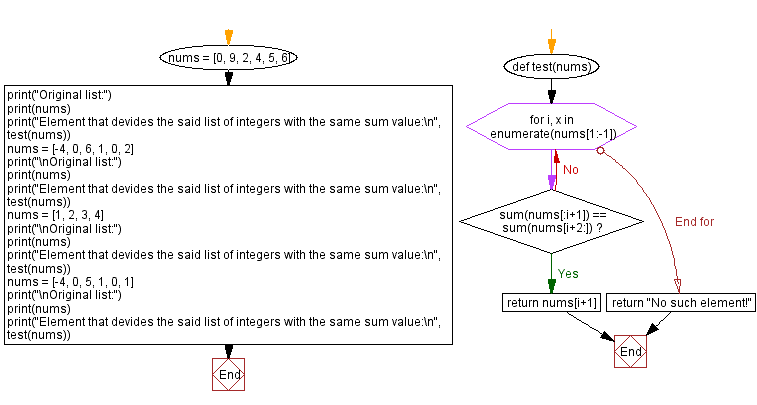Python Exercises: Divide a list of integers with the same sum value
Find Divisor with Equal Sums
Write a Python program to find an element that divides a given list of integers with the same sum value.
Sample Solution-1:
Python Code:
# Define a function named 'test' that takes a list of integers 'nums' as input.
def test(nums):
# Iterate through the elements of 'nums' using 'enumerate'.
for i, x in enumerate(nums[1:-1]):
# Check if the sum of elements on the left of 'x' (before the current index)
# is equal to the sum of elements on the right of 'x' (after the next index).
if sum(nums[:i+1]) == sum(nums[i+2:]):
# If the condition is met, return the element 'x'.
return nums[i+1]
# If no such element is found, return a message indicating that there's no such element.
return "No such element!"
# Define a list of integers 'nums'.
nums = [0, 9, 2, 4, 5, 6]
print("Original list:")
print(nums)
# Call the 'test' function to find an element that divides the list with the same sum value on both sides.
print("Element that divides the list with the same sum value:\n", test(nums))
# Define another list of integers 'nums'.
nums = [-4, 0, 6, 1, 0, 2]
print("\nOriginal list:")
print(nums)
# Call the 'test' function for the second list.
print("Element that divides the list with the same sum value:\n", test(nums))
# Define one more list of integers 'nums'.
nums = [1, 2, 3, 4]
print("\nOriginal list:")
print(nums)
# Call the 'test' function for the third list.
print("Element that divides the list with the same sum value:\n", test(nums))
# Define an additional list of integers 'nums'.
nums = [-4, 0, 5, 1, 0, 1]
print("\nOriginal list:")
print(nums)
# Call the 'test' function for the last list.
print("Element that divides the list with the same sum value:\n", test(nums))
Sample Output:
Original list: [0, 9, 2, 4, 5, 6] Element that devides the said list of integers with the same sum value: 4 Original list: [-4, 0, 6, 1, 0, 2] Element that devides the said list of integers with the same sum value: 1 Original list: [1, 2, 3, 4] Element that devides the said list of integers with the same sum value: No such element! Original list: [-4, 0, 5, 1, 0, 1] Element that devides the said list of integers with the same sum value: 1
Flowchart:

Sample Solution-2:
Python Code:
# Define a function named 'test' that takes a list of integers 'nums' as input.
def test(nums):
# Iterate through the indices of 'nums'.
for i in range(len(nums)):
# Check if the sum of elements from the beginning of 'nums' up to index 'i'
# is equal to the sum of elements from index 'i' to the end of 'nums'.
if sum(nums[0:i+1]) == sum(nums[i:]):
# If the condition is met, return the element at index 'i'.
return nums[i]
# If no such element is found, return a message indicating that there's no such element.
return "No such element!"
# Define a list of integers 'nums'.
nums = [0, 9, 2, 4, 5, 6]
print("Original list:")
print(nums)
# Call the 'test' function to find an element that divides the list with the same sum value on both sides.
print("Element that divides the list with the same sum value:\n", test(nums))
# Define another list of integers 'nums'.
nums = [-4, 0, 6, 1, 0, 2]
print("\nOriginal list:")
print(nums)
# Call the 'test' function for the second list.
print("Element that divides the list with the same sum value:\n", test(nums))
# Define one more list of integers 'nums'.
nums = [1, 2, 3, 4]
print("\nOriginal list:")
print(nums)
# Call the 'test' function for the third list.
print("Element that divides the list with the same sum value:\n", test(nums))
# Define an additional list of integers 'nums'.
nums = [-4, 0, 5, 1, 0, 1]
print("\nOriginal list:")
print(nums)
# Call the 'test' function for the last list.
print("Element that divides the list with the same sum value:\n", test(nums))
Sample Output:
Original list: [0, 9, 2, 4, 5, 6] Element that devides the said list of integers with the same sum value: 4 Original list: [-4, 0, 6, 1, 0, 2] Element that devides the said list of integers with the same sum value: 1 Original list: [1, 2, 3, 4] Element that devides the said list of integers with the same sum value: No such element! Original list: [-4, 0, 5, 1, 0, 1] Element that devides the said list of integers with the same sum value: 1
Flowchart:

For more Practice: Solve these Related Problems:
- Write a Python program to find a pivot index in a list where the sum of elements on the left equals the sum on the right.
- Write a Python program to identify all pivot indices in a list with equal left and right sums.
- Write a Python program to check if a list can be partitioned into two parts with equal sums.
- Write a Python program to find the element which, when removed, results in equal sums on both sides of the list.
Go to:
Previous Python Exercise: Generates a list of numbers in the arithmetic progression within a range.
Next Python Exercise: Count lowercase letters in a list of words.
Python Code Editor:
What is the difficulty level of this exercise?
Test your Programming skills with w3resource's quiz.
